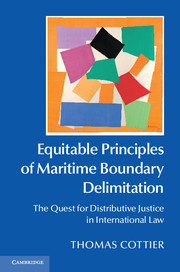 Equitable Principles of Maritime Boundary Delimitation
Equitable Principles of Maritime Boundary Delimitation from PART I - Context: the enclosure of the seas
Published online by Cambridge University Press: 05 May 2015
The quest for global equity in maritime law
With a view to preparing the ground for rules and principles on maritime boundary delimitation, it is essential to consider the global distributive effects of the new law of the sea, particularly those of the continental shelf and the EEZ. Global, ‘macro-economic’ distributive effects and the changes brought about by these concepts may be relevant in the succeeding process of ‘micro-economic’ maritime boundary delimitation between states. Both levels operate with elusive notions of equity, and it is yet unclear how they interrelate. A brief study of distributive effects in law and the economics of the enclosure of the seas is therefore necessary to define the scope of equity in the context of maritime boundary delimitation. It prepares the ground for the clarification of the relationship of what may be called global equity in the law of the sea and the use of equity in maritime boundary delimitation in subsequent chapters of this book.
The history of the enclosure movement reveals that the EEZ and the Area became an important part of the movement for a new international economic order (NIEO) from the 1970s to the 1980s. While the legal concept of the shelf emerged from policies put forth by industrial and colonial powers, the subsequent developments of the EEZ and the Area – under the concept of common heritage – were largely promoted by developing countries (LDCs) under the flag of equity, with the hope of achieving fundamental changes in the allocation of income, wealth and resources. In the 1970s, UNCLOS III became a central operation in the pursuit of power sharing and of distributive justice or global equity:
The developing countries have found that the international conferences on the law of the sea provide them with a unique opportunity for ensuring that their own ideas and needs are borne in mind in the formulation of the rules of international law and that the rules are formulated on the basis of equity.
To save this book to your Kindle, first ensure no-reply@cambridge.org is added to your Approved Personal Document E-mail List under your Personal Document Settings on the Manage Your Content and Devices page of your Amazon account. Then enter the ‘name’ part of your Kindle email address below. Find out more about saving to your Kindle.
Note you can select to save to either the @free.kindle.com or @kindle.com variations. ‘@free.kindle.com’ emails are free but can only be saved to your device when it is connected to wi-fi. ‘@kindle.com’ emails can be delivered even when you are not connected to wi-fi, but note that service fees apply.
Find out more about the Kindle Personal Document Service.
To save content items to your account, please confirm that you agree to abide by our usage policies. If this is the first time you use this feature, you will be asked to authorise Cambridge Core to connect with your account. Find out more about saving content to Dropbox.
To save content items to your account, please confirm that you agree to abide by our usage policies. If this is the first time you use this feature, you will be asked to authorise Cambridge Core to connect with your account. Find out more about saving content to Google Drive.